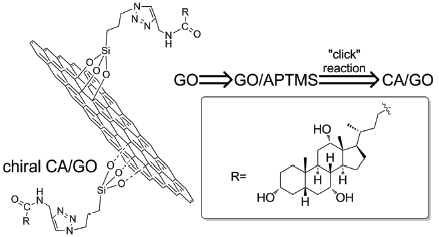| [1] Chen, D.; Feng, H. B.; Li, J. H. Chem. Rev. 2012, 112, 6027.
[2] Konkena, B.; Vasudevan, S. J. Phys. Chem. Lett. 2012, 3, 867.
[3] Tang, Q.; Zhou, Z.; Chen, Z. Nanoscale 2013, 5, 4541.
[4] Wei, W.; Qu, K.; Ren, J.; Qu, X. Chem. Sci. 2011, 2, 2050.
[5] Loh, K. P.; Bao, Q.; Ang, P. K.; Yang, J. J. Mater. Chem. 2010, 20, 2277.
[6] Zhang, Q.; Wu, S.; Zhang, L.; Lu, J.; Verproot, F.; Liu, Y.; Xing, Z.; Li, J.; Song, X. M. Biosens. Bioelectron. 2011, 26, 2632.
[7] Fang, M.; Wang, K. G.; Lu, H. B.; Yang, Y. L.; Nutt, S. J. Mater. Chem. 2009, 19, 7098.
[8] Wang, Q.; Chan, T. R.; Hilgraf, R.; Fokin, V. V.; Sharpless, K. B.; Finn, M. J. Am. Chem. Soc. 2003, 125, 3192.
[9] Mortisen, D.; Peroglio, M.; Alini, M.; Eglin, D. Biomacromolecules 2010, 11, 1261.
[10] Yang, X.; Ma, L.; Wang, S.; Li, Y.; Tu, Y.; Zhu, X. Polymer 2011, 52, 3046.
[11] (a) Ren, C.; Chen, Y.; Zhang, H.; Deng, J. Macromol. Rapid Commun. 2013, 34, 1368.
(b) Li, W.; Liang, J.; Yang, W.; Deng, J. ACS Appl. Mater. Interfaces 2014, 6, 9790.
(c) Li, W.; Liu, X.; Qian, G.; Deng, J. Chem. Mater. 2014, 26, 1948.
[12] (a) Guo, C. X.; Zhang, L. Y.; Miao, J.; Zhang, J.; Li, C. M. Adv. Energy. Mater. 2013, 3, 167.
(b) Nasseri, M. A.; Allahresani, A.; Raissi, H. RSC Adv. 2014, 4, 26087.
(c) Hauser, A. W.; Mardirossian, N.; Panetier, J. A.; Head-Gordon, M.; Bell, A. T.; Schwerdtfeger, P. Angew. Chem., Int. Ed. 2014, 53, 1.
(d) Gu, H.; Zhou, N.-L.; Fan, Y.-T.; Wang, X.-D.; Li, W.-X.; Shen, J. Chem. J. Chin. Univ. 2013, 34, 479. (顾皓, 周宁琳, 樊云婷, 王晓丹, 李文秀, 沈健, 高等学校化学学报, 2013, 34, 479.)
(e) Mo, Z.; Gou, H.; He, J.; Yang, P.; Feng, C.; Guo, R. Appl. Surf. Sci. 2012, 258, 8623.
[13] Hofmann, A. F. News Physiol. Sci. 1999, 14, 24.
[14] Mukhopadhyay, S.; Maitra, U. Curr. Sci. India. 2004, 87, 1666.
[15] Zhu, X. X.; Nichifor, M. Acc. Chem. Res. 2002, 35, 539.
[16] Davis, A. P. Molecules 2007, 12, 2106.
[17] Meyer, J. C.; Geim, A. K.; Katsnelson, M.; Novoselov, K.; Booth, T.; Roth, S. Nature 2007, 446, 60.
[18] Oh, J.; Lee, J. H.; Koo, J. C.; Choi, H. R.; Lee, Y.; Kim, T.; Luong, N. D.; Nam, J. D. J. Mater. Chem. 2010, 20, 9200.
[19] Wang, H.; Hu, Y. H. Ind. Eng. Chem. Res. 2011, 50, 6132.
[20] Stankovich, S.; Piner, R. D.; Chen, X.; Wu, N.; Nguyen, S. T.; Ruoff, R. S. J. Mater. Chem. 2006, 16, 155.
[21] Hummers, W. S.; Offeman, R. E. J. Am. Chem. Soc. 1958, 80, 1139.
[22] Zhang, D.; Song, C.; Deng, J.; Yang, W. Macromolecules 2012, 45, 7329.
[23] Meng, D.; Sun, J.; Jiang, S.; Zeng, Y.; Li, Y.; Yan, S.; Geng, J.; Huang, Y. J. Mater. Chem. 2012, 22, 21583.
[24] Pan, Y.; Bao, H.; Sahoo, N. G.; Wu, T.; Li, L. Adv. Funct. Mater. 2011, 21, 2754.
[25] Lin, Y.-W.; Guo, X.-F. Acta Chim. Sinica 2014, 72, 277. (林源为, 郭雪峰, 化学学报, 2014, 72, 277.)
[26] Lai, C.-W.; Sun, Y.; Yang, H.; Zhang, X.-Q.; Lin, B.-P. Acta Chim. Sinica 2013, 71, 1201. (来常伟, 孙莹, 杨洪, 张雪勤, 林保平, 化学学报, 2013, 71, 1201.)
[27] Wu, J.-X.; Xu, H.; Zhang, J. Acta Chim. Sinica 2014, 72, 301. (吴娟霞, 徐华, 张锦, 化学学报, 2014, 72, 301.) |
